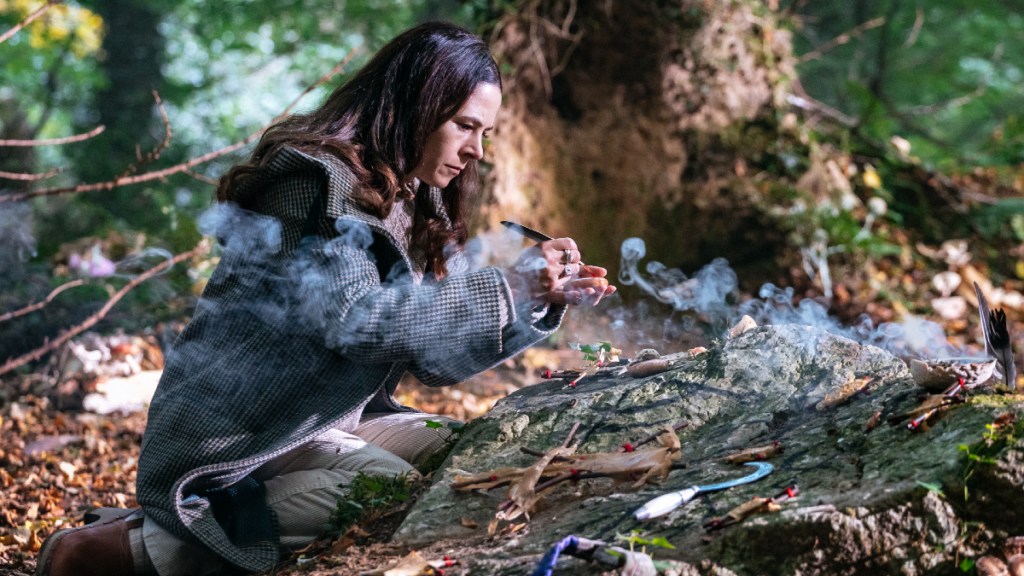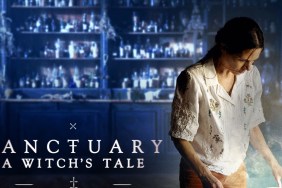If there were any doubt that Sanctuary: A Witch’s Tale draws inspiration from Twin Peaks, look no further than the character names. The lead witch is named Sarah Fenn, one of her friends is called Cheryl Lee, and midway through the show a newcomer named Lynch shows up. The template’s highly similar, too: the mysterious death of an extremely popular high schooler leads an outsider cop to a quirky small town where things happen that definitely are not normal. In investigating, the detective learns that pretty much everybody has nasty secrets, and the victim was into way darker stuff than anyone pretended to suspect.

Rather than vagaries about a Black Lodge, however, Sanctuary tells you what’s up right in the title: this is a town, and a reality, where witchcraft is legal. Despite this, there’s only one actual registered witch living there, the aforementioned Ms. Fenn (Elaine Cassidy). It’s an expensive seaside town in England, so most of the residents are insulated rich folks who are perfectly nice neighbors unless and until they start feeling threatened in any way.
Branching David-ian
Don’t expect the surrealism of David Lynch, as the homage is mostly in the set-up, and the seven-episode arc mostly resolves every loose end by the time the final credits run. (There’s room for a second season should there be demand, but it would presumably involve a different case or town.) The establishing elements that aren’t Lynchian feel like they could exist in adult Harry Potter’s world — the parts where mostly Muggles roam and outnumber the local witch — minus J.K. Rowling’s unfortunate stereotypes, of course.
Being a British show, Sanctuary is full of casual diversity without conspicuous self-back-patting over it, including a nonbinary witch whose pronouns nobody makes a big deal of. This also largely avoids making the witches an obviously direct allegory for any particular group, since there’s representation across the board.

Arthur Miller’s The Crucible invariably casts a long shadow on any story about witches and witch hunts, and that remains true here as well, as hysteria proves addictive, and demonization easy. The star football (soccer) player died from falling down stairs, but did he trip, was he pushed, or did a curse make him do it? You can probably guess which option the townspeople mostly gravitate towards. Sarah’s daughter Harper (Hazel Doupe) is a prime suspect, but despite her mother’s genetics, she has never manifested witch powers. Sarah’s the only one that anybody knows of with power, and she has a pretty solid alibi having hung out with her coven that night (said coven being three friends who can amplify her powers but have none of their own). Plus, just from a plot perspective, Sarah would be much too obvious a suspect.
Hot or Not?
Typically one might suspect that a show about witches, and an accused teen witch in particular, might be a YA-skewing, CW-style show full of model types. Sanctuary’s not that, at all — its teens look surprisingly normal, but the story skews toward the parental characters, and aims at an audience of the sort of parents who like crime dramas. But if you’re looking to fulfill a spellcaster fetish, look elsewhere. Aside from Detective Maggie Knight (Stephanie Levi-John) briefly getting some implicit action, there’s no sex here save the nonconsensual, criminal kind. Characters talk a lot about past instances of cheating on their spouses, but we don’t get to actually see any of that.

Likely viewers are advised to hang in there till at least episode 2 — the first one is surprisingly uninvolving at first, with an opening teaser that won’t pay off for quite a while and practically demands a rewatch when it finally does. The mythology does a slow build, initially putting the audience as much in the dark about the rules of witchcraft as the more ignorant townspeople are. This also allows for more red herrings — your suspicions may shift a few times, but by the end, it doesn’t feel cheap. Anyone with shade cast their way has something relevant going on, even if they aren’t the guilty party. It’s not like a Scream sequel where everything is misdirection, and therefore, via Incredibles logic, nothing is.
Scare Tissue
While Sanctuary may not feel much like horror at first, the final episode does indeed deliver the catharsis that all the built-up tension requires. It doesn’t solve all the prejudice, but it doesn’t seem like an unfair spoiler to say that certain prejudiced people will pay for it, which is one area in which the show is better than real life.
Supernaturally powered witches may not be real, but the places the show goes with misdirected anger, friends turning on friends in their grief, and insecure narcissists firing up prejudices and scapegoating gets scarily realistic. Does it offer a preview of what’s to come in an election year for the rest of us? Perhaps it can be a cautionary tale, but nobody’s out here casting spells to save us. The real horror is the friends you lose along the way.

Real Wiccans may appreciate the way witch law holds consent sacred herein; they may groan at some of the rest, but understand the way ethical lapses can emerge — and backfire! — out of an overly enthusiastic desire to help. Many small details are left to the viewer to pick up, which is nice. The show may give you all the big answers, but it doesn’t assume you’re too stupid to pick up on small pointers.
The Verdict:
It’s a nice balance, overall. Sanctuary isn’t one of those “rush out and buy the DVD set now” all-timers, but it’s solidly engaging entertainment while you watch. More shows used to have such brief bewitchings.
Grade: 7/10
As per ComingSoon’s review policy, 7/10 is ”Good.” A successful piece of entertainment that is worth checking out, but it may not appeal to everyone.
Sanctuary: A Witch’s Tale debuts with a two-episode premiere on Thursday, January 4, exclusively on Sundance Now and AMC+, with new episodes airing weekly.










